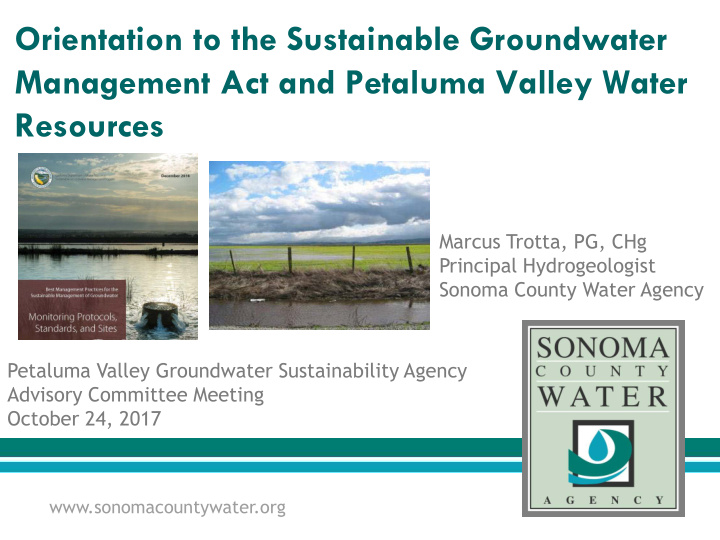



. Orientation to the Sustainable Groundwater Management Act and Petaluma Valley Water Resources Marcus Trotta, PG, CHg Principal Hydrogeologist Sonoma County Water Agency Petaluma Valley Groundwater Sustainability Agency Advisory Committee Meeting October 24, 2017 www.sonomacountywater.org
Sustainable Groundwater Management Act Became law on January 1, 2015 Applies statewide to medium and high priority basins In Sonoma County, affects Santa Rosa Plain, Sonoma Valley, Petaluma Valley
Required Steps to Groundwater Sustainability Step one Step two Step three Form Develop Achieve Groundwater Groundwater Sustainability Sustainability Sustainability 20 years Agency Plan after June 30, 2017 January 31, adoption of - Complete 2022 plan* * DWR may grant up to two, five- year extensions on implementation upon showing of good cause and progress Failure to meet any of these deadlines triggers intervention by the State Water Resources Control Board
Management Authorities under SGMA Groundwater Sustainability Agencies have discretionary authority to: • Conduct studies • Register & monitor wells • Set well spacing requirements • Require extraction reporting* • Regulate extractions • Implement capital projects • Assess fees to cover costs *GSAs can’t require metering of domestic groundwater users, considered “de mininimis ” users under SGMA ( Use 2 acre-feet per year or less for domestic purposes)
Groundwater Sustainability Agency (GSA) Framework Structure Sonoma Petaluma Valley Valley GSA & GSP GSA & GSP Santa Rosa Plain 1 GSA & 1 GSP per GSA & GSP basin with formal coordination between basins
Basic Petaluma Valley GSA Governance Structure GSA Board: Five GSA staff members Advisory Committee: 10 members
Consideration of Interested Parties GSAs must consider “all interests of all beneficial uses and users of groundwater” including: ▪ Agriculture ▪ Domestic users ▪ Public & private water systems ▪ Tribes ▪ Environmental users ▪ Disadvantaged communities ▪ Others
Advisory Committees Advise GSA Board on: Development and implementation of Groundwater Sustainability plan Sustainability goals, measurable thresholds and objectives Technical and reporting standards Monitoring programs Modeling activities Project and management actions Annual work plans and reports Community Outreach Fee proposals Local Regulations to implement SGMA Inter-basin coordination General advisory
GSA Primary Future Activities (through June 2018) Prepare and adopt Bylaws Prepare and submit application for Proposition 1 Grant Funding Develop Community Outreach Plan Obtain consultant to initiate long-term funding options study Initiate development of Groundwater Sustainability Plan
Integrated Water Resource Management Strategies Recycled Water Surface Water Balance Maximize Groundwater Conservation
Russian River Watershed Lake Mendocino Lake Sonoma
Recycled Water • Petaluma Recycled Water System – Provides recycled water to agricultural customers, golf courses, urban landscaping, and Ellis Creek Water Recycling Facility – In 2016, ECWRF delivered 38 MG of tertiary recycled water to parks and schools, offsetting the need for potable water – In addition, 389 MG went to agricultural customers and golf courses that were previously using pumped groundwater or captured runoff as a water source – City is working on project to expand RW delivery to additional schools, parks, and the SRJC on the east side of town
Example Regional Water Conservation Efforts • Sonoma-Marin Saving Water Partnership – City of Petaluma Programs • LandSmart Plans • Sustainable Winegrowing Practices • SlowIt! SpreadIt! SinkIt! StoreIt!
Petaluma Valley Water Supplies and Primary Uses Imported Russian Groundwater River Water • Agriculture • Rural Residents • City of Petaluma (Primary Supply) • City of Petaluma (Back-up Supply) Local Surface Water Recycled Water • Agriculture • Agriculture (Offsets potable and • Golf Courses groundwater supplies) • Landscaping
Historical Petaluma Valley Groundwater Studies DWR, 1982 USGS, 1958
Groundwater Plays Important Role in Building Resiliency Santa Rosa Plain Study completed 2014. Groundwater management plan since 2014 Alexander Valley Study completed 2006 Sonoma County Water Agency Sonoma Valley Study Transmission System – completed 2006. Connecting Surface & Groundwater Groundwater management plan since 2007 Overarching Goal: Proactive Management of Surface Water & Groundwater Resources to Promote Reliability for All Users Petaluma Valley Study initiated Sept 2014
U.S. Geological Survey Groundwater Study • 3-Year Study scheduled for completion late 2017, report publication 2018 – Compiling & evaluating existing data – Collecting new data (geologic data, groundwater levels, groundwater quality and streamflows) – Developing groundwater flow model • Will form technical foundation for developing Groundwater Sustainability Plan (required by SGMA)
Petaluma V alley Groundwater Basin • Petaluma V alley Basin – 46,000 acres • Geology – complex and faulted • Many aquifers with high clay content –relatively low well capacities • Variable trends in groundwater levels • Water Quality issues in some areas - nitrates, salinity, iron/manganese, arsenic Digital geologic map from California Geological Survey
GSP Requirements Groundwater Sustainability Plans must: • Describe the basin conditions, using a hydrologic conceptual model • Describe the basin-specific monitoring network • Establish minimum thresholds and measurable objectives to avoid undesirable results: Groundwater-level Declines Reduction in Groundwater Storage Seawater Intrusion Water Quality Degradation Land Subsidence Surface Water Depletion • Identify projects and actions needed to achieve or maintain sustainable conditions within 20 years Must be completed by January 31, 2022
Maximize Outside Funding through Grant Opportunities • DWR has allocated ~$86 million statewide and released a Draft Grant Solicitation through Proposition 1. • Based on Draft Grant Solicitation, Petaluma Valley subbasin could be eligible for up to $1 Million in grant funding with a 50% local cost share requirement. • Grant applications due on December 1, 2017. • Other outside funding opportunities available through DWR – Facilitation services – Technical assistance, including funding for monitoring networks • Continue to explore other outside funding opportunities
Draft GSP Scope Objectives for Grant Application • Meet SGMA requirements - establish criteria and management actions to achieve and maintain sustainable groundwater. • Build on strong technical foundation established through previous technical studies and voluntary groundwater management activities. • Provide opportunity for significant public and community engagement and integrate the perspectives and address the needs of the many diverse users and uses of groundwater resources within the basin. • Leverage local resources through continued regional coordination and information sharing.
Questions and Discussion http://www.sonomacountygroundwater.org
Recommend
More recommend